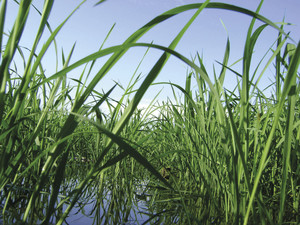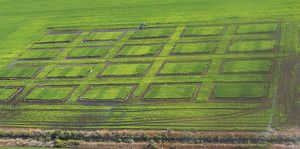
ANDREW BORJA REIS/ESALQ-USP
One of the experiments conducted in Tocantins, a traditional rice paddy with standing waterANDREW BORJA REIS/ESALQ-USPIn the late 1970s, rice producers from the state of Rio Grande do Sul began to migrate to northern Goiás; they were looking for cheaper land but also considering increases in the population and food demand. When the region became the new state of Tocantins in 1988, new waves of rice farmers from various regions of Brazil settled there; these farmers brought with them their cultivation techniques, most notably continuous flooding of the rice paddies during the crop development cycle. Because water scarcity is one of the main challenges of global agriculture, agronomist and engineer André Borja Reis (who worked as a consultant on farms in the region) developed an irrigation model that uses up to 50% less water and 15% less fertilizer while increasing productivity by up to 25%. Reis created this irrigation management technique while completing his doctorate at the Luiz de Queiroz College of Agriculture of the University of São Paulo (ESALQ-USP) in Piracicaba, under the guidance of professor José Laércio Favarin.
Reis recounts that while working as an agronomist in the rice-growing region of Tocantins, more precisely in Lagoa da Confusão, roughly 200 kilometers from the state capital, Palmas, he identified the main challenge to local producers: how to reduce the amount of water needed for irrigation without negative impacts on plant development or the environment. “The situation deserved to be the subject of scientific study,” says Reis. Rice plants are naturally adapted to flooded soil since their respiration takes place through specialized vascular structures known as aerenchyma, which capture oxygen from the atmosphere and channel it to cells in the roots. Most plants extract oxygen directly from the ground through their roots, and cannot survive in a flooded environment.
According to Reis, the common recommendation in traditional rice-growing regions in Brazil and around the world, in areas like Asia and the United States, is to irrigate the plants by flooding the fields; in other words, keeping the plants in water. “When the soil is flooded, this creates an environment where nitrogen remains available, whether it is present in the soil or added as a fertilizer, which reduces losses and increases its absorption by the plant. But this requires a considerable amount of water, and depending on the size of the area and the availability of resources, may make planting rice unfeasible.”
Replacing the continuous flooding model with a process using less water requires careful attention to losses of nitrogen, because without this element, productivity falls dramatically. In order to develop an alternative technique, Reis conducted a field experiment over three years (2014–2017) which spanned an area of 2,500 square meters (0.25 hectares) and involved a partnership with local farmers who plant approximately 70,000 hectares (ha) of rice. He tested five different irrigation regimes: the traditional system using permanent flooding, two combinations alternating flooding and drainage in different cycles, saturated soil without standing water on the surface, and unsaturated soil with moisture content levels near the soil’s absorption capacity.
According to Reis, varying amounts of nitrogen were added to all of the models. The objective was to verify crop productivity in each irrigation regime. Urea enriched with stable nitrogen 15 isotopes (15N) was also used to trace this fertilizer in the soil and within the plant and in subsequent specific analyses, for example in studies of how the irrigation regime affected the plant’s uptake. The nitrogen 15 isotope is a natural, non-radioactive element which is distinguished by the number of neutrons present in its nucleus.

ANDREW BORJA REIS/ESALQ-USP
In Lagoa da Confusão, Tocantins, a new system of planting rice in moist but unflooded soil was establishedANDREW BORJA REIS/ESALQ-USPLess impact
The study indicated that for the type of soil in that region of Tocantins, which is old, chemically depleted, and very porous, the best system was the unsaturated regime. “This alternative irrigation method fully meets the crop’s water needs, but uses less liquid than flooding while also increasing nitrogen availability,” states Reis. In this system, the ground keeps the soil’s micropores partially filled with water, approximately 60%, and the remainder is filled with air; in other words, the soil is very humid, but no standing water is present. This provides water for the crop to develop, as well as oxygen. “We believe that the model which was developed has less environmental impact in terms of conserving nitrogen in the soil-plant system, since the loss of this nutrient into the environment was reduced by 40%.”
Brazil has 1.97 million hectares planted with rice; of this total, 1.45 million ha are irrigated, and the remainder is dryland rice, using cultivars planted in unirrigated soil which consequently require a rainy period sufficient for the crop to complete its life cycle. The country is expected to harvest 11.5 million tons of rice in the next cycle, a growth of 8.5% over 2015/2016. Reis’ model, however, will not entirely replace the traditional practice, which is mainly used in southern Brazilian states. “What we are proposing is only suitable for soils in the Cerrado region, kept partially moist [60%],” he explains.
According to researcher Luís Fernando Stone, of the Rice and Bean Agro-Environmental Analysis Laboratory of the Brazilian Agricultural Research Corporation (EMBRAPA) in Santo Antônio de Goiás, Goiás, Reis’ irrigation model is a real novelty in the country. “What has been studied in Brazil as an alternative to the traditional system is intermittent submersion, which consists of cycles of flooding,” says Stone, who considers the new method promising for tropical lowlands with characteristics similar to those used in the study. Reis says that his system can be used in the floodplain of the Araguaia River Valley, in addition to other regions in the Cerrado drylands, or even in Africa.
Republish